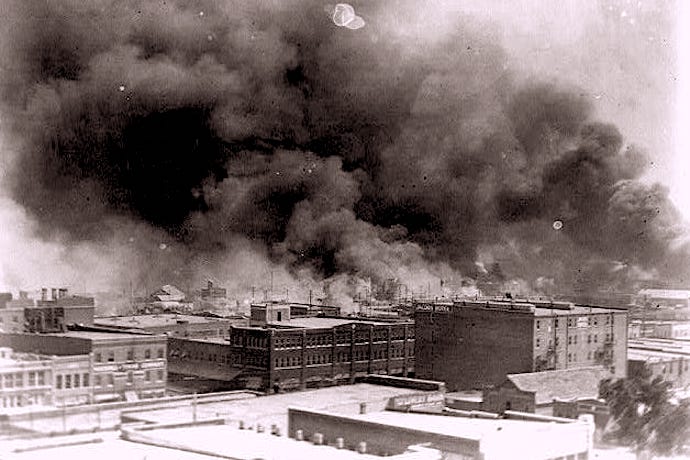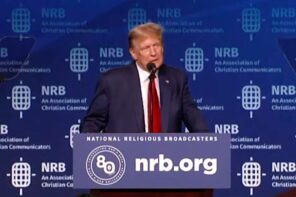“Black Wall Street” is a name that has evoked pride in countless African Americans as an example of economic resilience and self-sufficiency during the nadir of Jim Crow segregation. Black Wall Street was the name given to the Greenwood district of Tulsa, Oklahoma which was the hub of African-American businesses and cultural life. However, Black Wall Street was applicable to several Black business districts throughout the South, including places like Durham, North Carolina. Black neighborhoods were designated with names like “Black Wall Street, “Little Africa,” and “Little Hayti” (named for the island nation of Haiti).
Whereas many Black business districts would succumb to economic factors such as integration and urban development, the Greenwood neighborhood met a far grimmer fate. From May 31st through June 1st 1921, the Greenwood district of Tulsa, Oklahoma was decimated in what has come to be known as the Tulsa Race Massacre, often considered the worst race riot in American history.
However, this event has long only been remembered in Black newspapers and magazines such as Jet and Ebony, taught in history courses at historically Black colleges or Black Studies classes, and discussed in Black barbershops and family gatherings as a subjugated narrative that African Americans have passed on over the intervening century. The worst racial violence in American history was and continues to be largely absent from secondary school U.S history textbooks and curriculum. Nor was the Tulsa Massacre dramatized in documentaries for national audiences.
While this has begun to change as historians and activists have worked to preserve the memories of those who survived and the legacy of those who perished in the massacre, the Tulsa Massacre is still a marginal event in the canon of American historical tragedies such as Pearl Harbor or September 11th. Of course, in many ways Tulsa wasn’t a unique or singular occurrence as the latter half of the 19th century and the first half of the 20th century was constantly racked by race riots as whites fought to preserve racial hierarchies in cities throughout the nation.
“Race riot” is such a curious phrase that’s been used to describe the Tulsa Massacre and other examples of white supremacist violence against African-American citizens. The term often gives the impression of two sides equally engaged in a pitched battle. However, race riots have been anything but equal distributions of violence. The death tallies of African Americans are as asymmetrical as the supposed “causes.” While rape accusations have been the most frequently cited cause for white supremacist violence against African Americans, economic growth and empowerment are far closer to the actual reasons for this violence. Greenwood, like Rosewood, Florida was an example of Black self-sufficiency that angered local white authorities.
This year commemorates the one-hundred-year anniversary of the white supremacist riot that destroyed much of the Greenwood district. On May 19, centenarian survivors of the massacre testified before the House Judiciary Subcommittee on the Constitution, Civil Rights, and Civil Liberties about their experiences over those two days. One of the survivors, Viola Fletcher shared the following:
“I still see Black men being shot, Black bodies lying in the street. I still smell smoke and see fire. I still see Black businesses being burned. I still hear airplanes flying overhead. I hear the screams; I have lived through the massacre every day.”
In Oklahoma, Black residents have fought for decades to bring attention, and more importantly restitution, to the Greenwood district. In 2001 Oklahoma established a commission to study the Tulsa Massacre. The 1921 Tulsa Race Riot Centennial Commission was established with the mission to “educate Oklahomans and Americans about the Race Massacre and its impact on the state and Nation; remember its victims and survivors; and create an environment conducive to fostering sustainable entrepreneurship and heritage tourism within the Greenwood District specifically, and North Tulsa generally.” In 2018, the John Hope Franklin Reconciliation Park, named for the eminent African-American historian, was dedicated with a 16-foot granite structure of three bronze sculptures representing actual pictures from the 1921 riot. The three sculptures represent Hostility, Humiliation and Hope.
In addition, the park features the Tower of Reconciliation, a memorial dedicated to African-American history. According to the John Hope Franklin Center the memorial tower represents:
“the migration of slaves with Native Americans on the Trail of Tears, the slave labor experience in the Territories, the 1st Kansas Colored Volunteer Infantry that won the Battle of Honey Springs – to statehood, the immigration of free blacks into Oklahoma, and the all-black towns and Greenwood. It honors Buck C. Franklin (prominent black attorney and Dr. Franklin’s father) and other early Tulsa black leaders.”
However, the Tulsa Race Massacre centennial commemoration falls against a racially charged backdrop. On May 25th there was a national focus on the one-year anniversary of the horrific murder of George Floyd, even as local, state and federal agencies continue to struggle with the appropriate response to police brutality and the continued deaths of unarmed African Americans at the hands of law enforcement. Also, as Tulsans of all backgrounds commemorate and memorialize the events of May and June of 1921, the Oklahoma legislature passed HB 1775, signed into law by Governor Kevin Stitt, which bans the use of critical race theory in public schools.
Although Governor Stitt assured Black Tulsans that the new legislation would not prevent teaching about the Tulsa Massacre, the intention is clear. Right-wing politicians wish to preserve the myth of American innocence by framing the Tulsa Massacre and other examples of racial violence as an aberration of America’s true character rather than an inherent trait. As seen from the reactionary response to the 1619 Project and the current demonization of critical race theory, African-American history presents a challenging conundrum. The desire to fold the trauma and tragedy of African-American history into a triumphalist narrative of freedom and justice for all, regardless of historical fact.
Social and political conservatives have an easy time locating the “villain” when it can be perceived as foreign. This nation is at ease with memorializing Pearl Harbor or September 11th as examples of foreign threats being unsuccessful in breaking American resolve. However it’s far harder for Americans to reckon with the villain within. Whether it’s the Trail of Tears, American slavery, Japanese internment, or the half-century of race riots, these internal tragedies must be reconciled with a rhetoric of American innocence.
This brings us to the terms like unity, forgiveness, hope and reconciliation which are frequently invoked to move the nation “past” these tragedies. Interracial unity prayers and interfaith services are offered as examples of racial reconciliation. Forgiveness without atonement is the most common result as mainstream Christian denominations offer official apologies with no substantial reparative actions or policies for those injured by the harmful theologies that justify racial violence.
As the events planned by the 1921 Tulsa Massacre Centennial Commission reveal, religious ceremonies figured prominently into the weekend’s activities including a Unity Faith Day, the dedication of a Prayer Wall at Vernon AME Church, and a candlelight vigil “on the streets of Greenwood, Archer, and Elgin for a moment of silence as we remember the victims of the 1921 Tulsa Race Massacre when the first shot was fired which started the massacre at 10:30 p.m. on May 31, 1921.”
While all of the events are important symbols, we should judge hope and reconciliation not by the sculptures, unity services, and prayers offered this past weekend but by the concrete actions taken to meet the objectives of the 1921 Tulsa Massacre Centennial Commission by removing obstacles to proper education regarding the role of upholding white supremacy as the root cause of the Tulsa Massacre and encouraging economic development and investment in Greenwood and North Tulsa.
Instead, the state has chosen to cut additional federal unemployment benefits which disproportionately affects African Americans, and HB 1775, which effectively signals a commitment to a white-washed version of history, is still the law of the land. Restoring unemployment benefits for the most vulnerable workers in our current economy and repealing HB 1775 would signal a commitment to hope and reconciliation that goes beyond mere symbolism. But in a state run entirely by Republicans nobody’s holding their breath.





